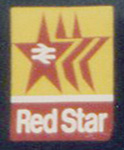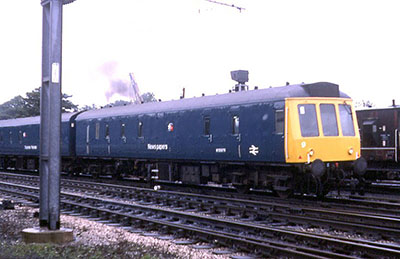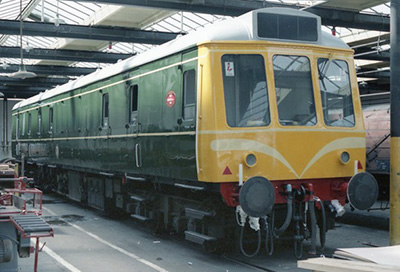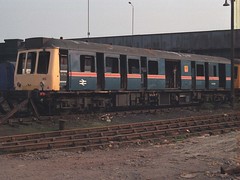Class 127 Derby 4-car DMUs
Parcel Use
Eleven two-car diesel parcel units (DPUs) were created in 1985. For most vehicles roller shutter doors were not initially fitted but were soon added.
Based in Manchester they worked to places such as Buxton, Workington, Cardiff, Liverpool and London Euston. The high power to weight ratio of the power twins allowed substantial tail loads.
They would be withdrawn in May 1989, three vehicles would enter preservation.
Background
A London Midland Region review of locomotive requirements showed that in the 1984/5 timetable there were 600,000 miles (17%) of Parcels Sector services which used a locomotive with three vans or less. These generated a low income compared to the high running costs involved. The Parcels Sector, which under Government guidelines had to be a profitable concern, would also be expected to contribute to the British Rail locomotive plan for any investments on new or refurbished locos used on these services. These service could not continue to be loco-hauled, and for the options available to them, operating the trains with dedicated parcel units was the best way forward.[1]
Recommissioning
At the start of 1985 the Parcels Sector approached the LM Region DMU Specialist Engineers section at Nelson Street, Derby, with a view to re-introducing some of Class 127 vehicles stored at Carlisle back to traffic. As a feasibility study 51633/5 were locomotive hauled from Carlisle to Newton Heath — it was thought this was where they would operate from, and they also had a little spare staff capacity.
Mike Boot, from the DMU Specialist Engineers section, was given the task to get them into traffic. He picks up the story: "The units duly arrived in February, I sent word to the depot to undertake a battery change, an initial B exam plus oil and fluids change and to check out the electrics and control systems, they were NOT to start the engines without me being there. On that day I got my overalls on and did a thorough inspection checking things over like the fire system and then went to the No.1 engine, pressed the excess fuel on the pump and pushed the button. I was amazed, she fired almost immediately, starting without any hesitation after a few revolutions and idled very smoothly after that. She did not cough once."
"We took it on an extended test run all the way from Manchester to Marylebone, you can imagine as a power twin with all four singing away happily she flew all the way. We had a few stops picking up traction inspectors for the route down. It was all round a successful run. On the way down I lifted a few trap doors to look at how things were going, of interest was the one over the final drives the way the shaft was spinning and seeing the bogie lurching around. Seriously, I think it was somewhere near an American Air Base the driver and inspector allowed her her head, so to speak, and she went totally off the speedometer, we guessed at the time it must have been around 90 MPH. That was short lived and was not done again! After both were re-commissioned we initially set about removing all of the interior and plated over the windows and in March we gave then over for use."
This first pair became 55970/80. They were presented to the newspaper trade for inspection at Manchester Victoria on March 12th. At the time the vehicles did not have any Newspaper/Express Parcels branding on the sides[2]. They were noted in Marylebone the next day[3] (possibly the outing described in the previous paragraph?), likely on display for HQ staff.
Alterations
Each set was formed of one vehicle designated for Newspapers (the A car) and one for Express Parcels (the B car).
All of the main bodyside windows were plated over, on the outside with steel and on the inside with wood. The A car had two doors taken out of use (door/commode handles removed and droplight plated over) on the drivers side - the first and sixth door from the cab, and three on the other side - the third, fourth and sixth doors. On the B cars just the sixth door was taken out of use on each side.
No roller shutters were fitted at this early stage. The loading of BRUTEs was done through the van doors, on most sets the inward opening door replaced by a second outward opening door. The floors were strengthed with chequer plate in the rear half of the vehicle for the BRUTES, with a hole added to the originally solid partition from the van through to the main area to allow the BRUTEs to pass through.
The interiors were stripped out. The A (Newspaper) cars had a fixed table in the front and fold-down table in the rear for newspaper packing / sorting, this area was heated, flourescently lit and retained two or four seats. Partitions were fitted behind the fourth door[3] (which would be lost when roller shutters were later fitted).
Opinions varied on allowed loads, p208 of the May 1985 Railway Observer noted each car was allowed to carry 14 tonnes and up to seven BRUTEs, and each set was allowed to tow 140 tonnes, normally four bogie vans. Page 30 of the June 1986 Rail Enthusiast stated each car could be loaded to to a maximum of 10 tonnes with up to 13 loaded BRUTEs and each set could tow 175 tonnes (five bogie vans). The differences could be due to being pre and post roller shutter door figures.
More sets
Ten sets were planned, using all twenty vehicles stored at Carlisle, and the four-month conversion programme was shared between Newton Heath and Carlisle Currock. On April 12th 55974/5 and 55981/2/4/6 were noted at Carlisle Currock.[4]
The second set converted made a trial run from Newton Heath to Rochdale on May 10th[5]. Work was noted underway on 55973 + 55983 at Newton Heath on June 16 while Longsight was working on 55975/85 and 55977/87[6].
After this initial conversion work the sets retained their plain blue livery, and soon a red star logo was added. The 'A' (Newspaper) vehicle would be the lowest numbered of the two. They were initially given a single digit set number corresponding to the last digit in the vehicle number.
The image shows set 9 (displayed on the left of the cab front in white) - 55979 and 55969 - at Carnforth 6/10/85. Robert Frise.
Roller Shutter Door Prototype
Mike Boot: "The Parcels side asked about the feasibility of fitting the roller doors. My colleague John Crawley was the one who looked at this and got the material together. Due to the reducing work load he had the first unit taken to Currock Wagon where the first “trial” fit was done. Using the front end was their request, structurally and weight wise this did not present any problems."
The vehicle used for the test fitting was M55974, and would be the only one to have the roller shutter door fitted to the front of the vehicle. BRUTEs could now be loaded at both ends. The conversion work was completed by the end of April.
Although it would not be converted to a parcel vehicle, DMBS M51617 — which had been stored at Derby since February 1983 — would be used by the LMR RM&EE department at Derby during the roller shutter design stages[7].

A parcel set heads for Manchester Piccadilly through Victoria station at 13:06 on the 27th June 1985. This working was previously done with a Class 128 propelling a GUV. Paul Moxon.
In traffic
The main base of operations for the converted units was Manchester Victoria station, for which vehicles were normally allocated to Newton Heath depot — yet the DPUs were allocated to Longsight. Longsight depot lost its allocation of passenger DMU vehicles on 12th May 1985.
Mike Boot explains: "Although the units were to operate out of NH due to the geographical placing of it and Manchester Victoria, I suggested that Longsight needed to be used for ongoing maintenance. The reason for this was they were about to close the diesel side down but it still had a steam locomotive wheel and pony truck drop pit which NH did not have. As the engine and torque converter needed to be changed as a unit, this was the only place which could do the job safely, drop the engine, move the unit and bring it back up, easy. So for this I can take some responsibility for keeping Longsight diesel side open. I also brought up two lads from Cricklewood to help the lads train for maintaining the units, Rolling Stock Inspector Pete Atkins and John Collins, a very good experienced fitter."
Although allocated to Longsight they could normally be seen stabled at Newton Heath during the day. Beginning in May 1985 they worked to places such as Barrow, Bradford, Southport, St.Helens and Blackpool on news and parcels trains during the night, at considerably less cost than the loco-hauled stock they replaced boosting profitability of the parcels sector[8]. The arrival of the sets also allowed the three Class 128s at Newton Heath to move to Tyseley in July 1985.
In traffic the vehicles were noted as being generally reliable. There was the occassional failure — in July 1985 this included 55980/55980 loosing torque oil while working the 4P06 21: 20 Blackpool North-Preston parcels on the 14th requiring them to be towed from Kirkham by 25 035, and 55974/55984 noted being hauled by 47 155 past Dalston after failing on the 1P55 Manchester-Barrow parcels on the 23rd.[9]
They were allowed to run with blue square sets, providing the blue square (gearbox) set was at the front. Sightings of these included Class 104/127 combos on the Buxton line.
Renumbering
Circa August 1985 a decision was made to renumber 55988 and 55989 as 55968 and 55969. The numbers 55988/9 had previously been used on Newton Heath Class 128 parcel cars, withdrawn in October 1980 and September 1982 respectively, and were probably causing confusion. 55987 had also been a Class 128, but withdrawn in 1971, too early to cause any problems, so the Class 127 with that number did not change.
The renumbering kept the consistency of the two vehicles in their sets being ten digits apart, but for these two sets the 'B' vehicles were now the lower numbered of the two vehicles. Both vehicles were still noted as carrying their original numbers in mid-October.[10]
An Eleventh Set - the Green Unit
The success of the first ten conversions created demand for another, and with the twenty power cars at Carlisle now all used two more vehicles had to be found. One of these - M51591 - came from the NRM. Stories differ over its reason for being there, some noting it was preserved, others that it was simply on loan. The second vehicle would be M51610, 'bought back' from scrapman Vic Berry. This vehicle was notable as being the only one of the ten vehicles that had continued on Gospel Oak services after withdrawal that didn't make it to storage at Carlisle. The vehicle was noted at York on 7th July 1985[11], possibly so the pair could travel together to Carlisle.
M51591, numerically the first of the class, had operated its final days in passenger traffic in a retro-green livery. Mike Boot: "I took the decision without letting anyone know to keep her in the green livery so I thought it be a good idea to do it’s mate the same. When she came out to Newton Heath, boy did I get it! I was kicked from one end of the corridor to the other but then given a pat on the back as she was a “flagship” for the business".
The image shows freshly painted 51591/55966 (still without number) at Currock after its initial conversion (pre-roller shutters). Mike Boot.
This set would be the only one to have the lower numbered vehicle as the B vehicle carrying Express Parcels lettering.
Roller Shutters for all
The parcels sector liked the roller shutter access on M55974 and wanted them retro fitted to the remainder of the fleet — but fitted centrally for better interior access.
When this decision was made the eleventh set was in the process of modification, 55966 has already reached the stage of being repainted, it would then have the roller shutter doors added before being released.
The green set was the first set to be released with the electrically operated centre positioned doors, and it was on display in Carlisle station - the vehicles positioned cab to cab - on 29 September 1985.[12]
The next three images show the completed doors. Note on the second image that the plated over main bodyside windows are painted in gloss, but the plated over droplights on the doors are matt black. The black sections would be used to chalk on destinations, which can be seen in this image.
All the other vehicles - except M55974 - would then visit Carlisle Currock to have the doors added. The eleventh (green) set probably helped to allow the others time out of their duties to for the trip to Currock. Mike Boot: "Currock had spare capacity and they, without drawings or any specifications or instructions, tackled the conversions and brand painting. Both myself and John Crawley made regular visits to to help and advise for the first few then on an irregular basis until all were completed."

The brand painting involved adding a red band (with a golden colour top and bottom edge) along the bodysides.
In the image 55987/55977, now with roller shutters and a red stripe, are framed in Victoria Bridge leaving Manchester Victoria at 08:58 on 23/11/85. Some vehicles, such as 55987 in the image, retained working headcodes. On it is displayed 9A - the steam shed code for Longsight - and 7 for set 917. Paul Moxon. Some vehicles also kept their destinations blinds, Barking being a popular observation on the units, others had the wooden box in the centre cab window removed.
The next three images shows the interiors of roller shutter door vehicles, thought to be 55966/7 just after conversion. The first, with the table, is the newspaper vehicle, the other show two the parcels vehicle. Mike Boot.

Around the same time set numbers were changed into the 9xx series, in black under the drivers window, with a small A or B suffix showing the vehicle type. And example from 919B is shown. One vehicle, 55984, would be the only car to retain the original set number (4) alongside the new (914), which it kept until withdrawal. The new number made it onto at least one set (912) before roller shutter doors were fitted.
Engines
Mike Boot: "Aware of the engine problems and the very serious shortage of the same, I saw it as a priority to try and stop them from having catastrophic failures. I consulted with a chap I had previously had dealings with at Rolls Royce who were now based in Shrewsbury, Richard Prideaux. Richard was very helpful and basically suggested we fit a silicone carbide liner and pistons fitted with chrome rings, I also sourced a Donaldson Air Filter similar to that on the 150 Sprinters and ordered another 20 HP reduction. This was very successful and from then on I do not think we had any further piston and liner problems."
"We did have one major failure over in Wales when one Torque Convertor ring broke down between it and the engine breaking her back so to speak and letting both halves down into the four foot. I also discovered at the time the M.O.D. had some overhauled and new engines in storage which were verticals, they had been used in "Antar" tank transporters but were no longer required. I went to have a look at them and was pleasantly surprised all were brand new and had not run. These were purchased for peanuts and shipped to Derby Locomotive Works for conversion to horizontals."
The Vehicles
The eleventh (green) set was the only one with adjacent vehicle numbers, not ten digits apart.
| Set numbers | 'A' vehicle | 'B' vehicle | 2 Outward | ||||||||||
|---|---|---|---|---|---|---|---|---|---|---|---|---|---|
| Initial | Later | Newspaper | 1 | 2 | Express Parcels | 1 | 2 | Converted | Van Doors | Logo | |||
| 910 | 55970 | (51635) | R | R | with | 55980 (51633) | R | R | Newton Heath | No | 2 | ||
| 1 | 911 | 55971 | (51597) | ? | L | 55981 (51612) | R | L | Newton Heath | Yes | Y | ||
| 912 | 55972 | (51611) | R | L | 55982 (51596) | R | L | No | Y | ||||
| 3 | 913 | 55973 | (51640) | L | L | 55983 (51624) | R | L | Newton Heath | No | Y | ||
| 4 | 914 | 55974 | (51642) | C | C | 55984 (51639) | R | L | Carlisle Currock | Yes | Y | ||
| 915 | 55975 | (51615) | L | L | 55985 (51619) | R | L | Yes | Y | ||||
| 6 | 916 | 55976 | (51625) | L | L | 55986 (51627) | R | L | Yes | Y | |||
| 917 | 55977 | (51603) | R | L | 55987 (51649) | R | L | Yes | 2 | ||||
| 8 | 918 | 55978 | (51608) | L | L | 55988 then 55968 (51637) | ? | L | Yes | 2 | |||
| 9 | 919 | 55979 | (51600) | R | L | 55989 then 55969 (51606) | R | R | Yes | Y | |||
| 920 | 55967 (51610) | L | L | 55966 | (51591) | L | L | Carlisle Currock | Yes | Y | |||
- Initial set numbers are only shown where these have been noted as being carried.
- There were inconsistencies in the placement of the 'Newspaper' and 'Express Parcels' bodyside text - the 1 and 2 columns for each vehicle note whether this was to the left or right of the roller shutter doors for the No.1 (drivers) and No.2 sides. 55974, with the front rollers shutters door, had the text in the centre of the vehicle.
- Converted location is where the initial conversion was done and only shown where there is evidence to confirm. Different sources have stated that either three, four or five sets were done at Newton Heath.
- Outward Van Doors - notes whether the van doors were converted to two outward opening doors.
- Logo - 2 means the set kept the overlapping white/red star logo till the end, Y means the yellow logo was applied at some point
1986

Stood alongside milepost 0 on what was the old Preston & Lancaster route, is set 910 (55980 + 55970), stabled for the weekend in Croft Street Sidings adjacent to Preston PSB on 23 March 1986. Martyn Hilbert.

Set 913 on the West Coast Main Line between Tring and Cheddington heading north with a Down Parcels Service, taken from a passing 310 Electric Unit on the down Fast Line on 24 May 1986. AndrewHA.

Set 915 at Buxton on 3 October 1986. The headcode displays 9A85, 9A for Longsight, 85 for 55985. Andrew J Crowther.
The green set became a 'celebrity' unit attending open days, such as at Birkenhead North as part of 'Merseyrail 100' on Sunday 6 April 1986. The return journey was with 120/116 parcel hybrid 51786 + 53051 which had been sent from Chester, the two sets departing from the depot at 22:09.[13]

Logo change
Pre-roller shutter doors some vehicles, but not all, carried the overlapping white/red stars on the bodysides, all vehicles had this logo by time the red band was added. The green set did not carry this version. By the time the two green vehicles were on display at Birkenhead North in April 1986 they carried had a new version of the logo (illustrated) which had red stars on a yellow background with a red band at the bottom for the red star text. The logos on all but three of the blue sets were updated to match.

Class 127s vs Class 08s
Incident One. 55975 was damaged circa April 1986 when it collided with a Class 08 at Longsight depot. Repairs were authorised, meanwhile partner 55985 would be paired with Class 101 driving trailer 54052 and be used on driver training duties.[14]
The image shows M55985 at Tyseley on 3 May 1986 coupled with 54052. This is the only known hybrid set formed with a Class 127 DPU vehicle. Andy Cole.
Incident Two. Circa May 1986 55974 collided with a Class 08 at Bletchley[15]. Its partner 55984 would now work paired with 55985, and as far is known the only out-of-course formation for these DPUs until 1989. The two Express Parcels vehicles worked together until at least late July 1987.
Both 55974 + 55975 had made it to Doncaster Works for repair by mid-July 1986. In this image no damage can be seen on the closest sides but 55975 has the centre cab window boarded up and some damage to the left of the cab.
Set 912 (55972 + 55982) were noted being towed by 47 329 on the 1P55 Manchester - Barrow and return newspaper service on 3 June 1986[16].
In 1986 regular workings were noted as including between Manchester, Crewe, Birmingham, Northampton, Hemel Hempstead, London Paddington and Euston involving some units covering almost 600 miles a day. At the time the Class 127 DPUs were expected to have a lifespan of up to five years with replacements envisaged as being a new order of 20 Class 15x "Sprinter" type single car parcel vehicles. These would be able to work in multiple with the Class 14x/15x DMUs scheduled to be introduced on passenger services in the DPU operating areas, which the 127s would not be able to.[1]

Another open day outing for the green set was at Carlisle Upperby on 19 July 1986. The image shows 55967 there alongside D200. John Grey Turner.
By Autumn failures were noted as being fairly common. The 16:00 Euston-Northampton, worked by 55983 + 55973, came to a stand with a seized torque convertor on 9 October. It had caused the drive shaft and engine casing to shatter leaving the engine just three inches off the ballast. The train blocked the down slow between Hemel Hempstead and Tring from 17:00 until it could be moved to Bletchley at 22:45. The same night the 22:08 Northampton-Euston worked by 55972 + 55982 failed at Bletchley which also meant the 01:10 Euston-Northampton was cancelled since no unit was available. The Parcels Sector were believed to be pushing for Sprinter parcel units to alllow the ailing DMUs to be withdrawn.[17]
Early Withdrawal
55974 would be withdrawn on 2 November 1986. While repairs had been authorised, with the work to include moving the roller shutter doors to the standard position[18], a revised estimate was rejected and it would be withdrawn instead. It would be returned to Longsight as a source of spares[19].
At the end of 1986 the LMR investigated the idea of creating three-car DPUs with the 127s. For the centre vehicle CCTs were considered but the cost and labour involved in adding control wiring and piping to these was prohibitive. Instead attention turned to Class 127 trailer seconds store at New Yard, Carlisle[19]. In the end nothing came of it.
Also at the end of 1986 "A" exams began to be undertaken at Bletchley depot which allowed better utilisation in the southern end of the Region[19].
1987
Class 127 vs EMU
Another set to suffer collision damage was 916 (55976 + 55986) after a collision with a Class 313 EMU on the 21:37 Euston-Watford at Camden on 6 January 1987. The Class 127 DPU was crossing from the down fast to down slow and all wheels were derailed resulting in the down main lines and up slow being blocked. Opinion varies on whether the EMU was 313007[20] or 313009 [21]. They were moved to Doncaster Works, where 55975 still remained waiting for a replacement torque converter before the work could be completed[22].
55975 was released from Doncaster in March 1987 while 55976/86 remained[23]. 55975 would not be re-united with its original partner 55985 until after mid-July. 55985 had been working with 55984, which was now without a partner since 55974 had been withdrawn, and I have found no images of 55984 in traffic after its split from 55985, so it may not have worked again.
In early 1987 the Longsight depot bird logo began to appear on the lower cab fronts, and LO depot stickers on the cab doors.
Circa May 1987 it was thought that some of the Class 127 DPU sets would be transferred to Chester[24]. This did not happen.
In July withdrawn 55974 would be cut up on site at Longsight by staff from Texas Metals.

Two sets pass though Northampton on 2 May 1987. Set 914 leads, M55984 displaying the Longsight logo on the cab. Lewis Bevan.
1988
When sector codes were introduced circa early 1988 all vehicles were assigned to RXXL (Parcels - General)[25]. At some point during the year this was changed to RXXN (Parcels - DPU cars)[26]. Another change came circa December with them now all being in pool RPXN (Parcels - DPU cars).[27]
In October 1988 they were introduced to the Manchester-Birmingham-Cardiff-Bristol-Southampton circuit[28].
Newspapers No More
Around August 1988 the Newspapers branding on the bodysides of the 'A' vehicles began to be removed.

Set 919 with 59979 closest (without 'Newspapers' on the bodyside) stabled at Cardiff Riverside on 31 December 1988. Robert Thomas.
The Class 127 DPUs replaced the loco and two-vans on the 15:10 Manchester-Bristol parcel service from 23rd November[29]. From November 28th they replaced locos on Crewe-Cardiff and Cardiff-Southampton parcel services[30]. For this 55976/86 moved from Longsight to Eastleigh on 9th November for staff training. The pair were noted failed at Canton on 8 December, 55972/82 took its place being seen in the parcels platform at Cardiff Riverside that day.[31]
Set 916 (55976 + 55986) working the 15:10 Manchester-Bristol parcels on 15 December with two vans in tow arrived late into Hereford at 19:00 and failed. The formation was shunted to Barrs Court Road sidings and taken south the next morning by 47143 as part of the Moreton-on-Lugg - East Usk Jct freight. A few days later the green set would also fail at Hereford, noted as arriving on the 20th with just one of the four engines working. It managed to deposit its two vans in Barrs Court Road sidings before the last engine expired. It would be taken south the next morning on the ex-Moreton-on-Lugg freight.[32]
One vehicle - 55981 - would be placed in store in December.[33]
1989 - the final year
Two more vehicles - 55973 + 55983 (set 913) were noted as being placed in store in January.[34]
The 15:10 Manchester-Bristol parcel service reverted back to a loco and two-vans from 23rd January, but on the same date the Class 127 DPUs took over from loco-haulage on the 19:00 Manchester-Cardiff parcel service.[29]
Also on the 23rd January the Cardiff-Southampton parcels services reverted to locos, as the 127s on these and the Crewe-Cardiff services were noted as performing unsatisfactorily, and Cambridge Class 114 DPUs had been noted running some of the services.[30]
The three previously stored vehicles (55973/81/83) were noted as being used for spares at Longsight. Due to the unreliabilty and unsuitablilty of the vehicles operating long distance services with trailing vans the Parcels Sector was reconsidering their future. Another six vehicles were noted as being placed in store in late February/early March - set 915 (55975/85), set 917 (55977/87), 55970 and 55984[35] — however 55970 as still in use in mid-March, 915 was still noted in traffic in May and this image shows set 917 running under its own power at Crewe in April.
From the 20th March the weekday Crewe-Cardiff parcel services reverted to locomotive haulage. The last DPU working on the route was the 15:10 (SO) Manchester-Cardiff from which as set was detached to work the 19:02 Newport-Bristol. The return working saw the two units departing Cardiff at 20:20 (SO) and Bristol at 19:45 (SO), they combined at Newport then departed at 20:53 running empty to Longsight. DPU use on the services was scheduled to end completely after the end of the current timetable on Saturday 13th May.[30]
On the 8th April two sets with a tail load were noted arriving into Stockport with an outward opening van door wide open on 55975.
By April 8th 55966 had had its 1,250,000 mile plaques removed. They had last been noted fitted on 22nd March.

M55984 inside the factory at Tyseley on 1 April - the vehicle status was 'stored'. Sets at Tyseley were not unusual during this period. Andy Cole.

Set 916 (M55986 closest) heads south past the site of Burton Latimer & Isham station on 19 April 1989. Mike Dean.

Green set 920, a blue set, and a tail load of a BG form the 3V20 Manchester Piccadilly - Bristol Temple Meads at Crewe on 6 May. Robert Chilton Collection.
Note in the third image above neither of the blue vehicles have 'Express Parcels' on the bodyside - so could this be two former Newspaper vehicles working together? Also, the closest of the blue vehicles appears to be missing the plate from a bodyside window (which can also be seen in this image of the same train).
All were withdrawn on Monday 15th May 1989 with the introduction of the summer timetable.

Probably their last day in traffic - sets 915 and 920 pass up the centre road at Northampton Station at approx. 15:00 on Saturday 13 May 1989. AndrewHA.
Disposal
For the twenty-two vehicles 55974 had already been cut up (at Longsight in 1987), three would be preserved, fourteen cut up at Vic Berry's, three at Snailwell and one at Crewe.

The green set 920 (55966/7) and blue vehicles set 916 (55976/86) and 55978/9 were noted being hauled south through Crewe on May 30 by 47324[36]. These six vehicles would end up in a siding around the back of the goods shed at Crewe Gresty Lane in this: order 55967 + 55966 - 55986 + 55976 - 55978 + 55979.
The image shows this six-vehicle line-up at Gresty Lane from the 55979 end on 8th July 1989. Of all the vehicles that would be stored at Crewe this row would be photographed the most due to the ease of accessibility. Paul James.

All other vehicles would be placed in store at Basford Hall Yard at Crewe, while possible re-use was considered.[37]
The image shows M55981 in Basford Hall Yard at Crewe on 21st July 1989. Paul James.
This 1990 view of Basford Hall Yard contains at least six blue sets, three on the left and three towards the centre (the closest of which has smashed cab windows).
The first vehicles to leave Crewe would be three of the six vehicles from Gresty Lane and these (green vehicles 55966 + 55967 and blue 55976) would enter preservation. They had departed from the goods shed siding by the end of May 1990 leaving just 55986 with 55978 + 55979 in that row.
In early March 1991 fourteen of the vehicles at Bashford Hall Yard would move to Vic Berry's at Leicester for disposal. A fire at that scrapyard on March 10th would lead to its closure soon after leaving the four vehicles remaining at Crewe (three at Gresty Lane and 55981) to be disposed of elsewhere.
A 17 vehicle formation of withdrawn vehicles from Chester and Longsight to Mayer Payer at Snailwell on 13 June 1991 contained one DPU vehicle[38]. This vehicle was 55981[39], which had previously been photographed at Bashford Hall - so had this vehicle moved on elsewhere, and perhaps explains why it was not included in the earlier mass move to Vic Berry's?
For the three vehicles in the goods shed siding, they were still together at the end of May 1991. 55986 is believed to have moved to the Crewe Heritage Centre to be used as a workshop by August 1991 but later returned to Gresty Lane[40]. While it was absent the other two - 55978/9 - had departed, moving to Snailwell for disposal in February 1992.
The final vehicle - 55986 - still listed under Rail Express Systems ownership in early 1994[41] - would be cut up on site at Gresty Lane by staff from J&S Metals in April 1994, ending the Class 127 DPU story.

Sets stand forlornly withdrawn in Crewe Basford Hall yard on 21 July 1990, with 55975 nearest. Robert Chilton
References
- ⋏ a b "Parcel cars - present and future", p30 June 1986 Rail Enthusiast
- ⋏ "Welcome Back to the Class 127s" p25 June 1985 Rail Enthusiast
- ⋏ a b p208 May 1985 Railway Observer
- ⋏ p262 June 1985 Railway Observer
- ⋏ "Traction Talk" p48 August 1985 Rail Enthusiast
- ⋏ "News lines" p28 September 1985 Rail Enthusiast
- ⋏ "Coaching Call" p55 May 1986 Rail Enthusiast
- ⋏ "Newton Heath - Heath Robinson no longer", p9 February 1986 Rail Enthusiast
- ⋏ "Traction Talk", p50 October 1985 Rail Enthusiast
- ⋏ p562 December 1985 Railway Observer
- ⋏ p415 September 1985 Railway Observer
- ⋏ p125 March 1986 Modern Railways
- ⋏ "Merseyrail 100", p12 July 1986 Rail Enthusiast
- ⋏ "Multiple Matters" p39 July 1986 Rail magazine
- ⋏ "Traction Talk" p49 September 1986 Rail magazine
- ⋏ "Traction Talk" p50 October 1986 Rail magazine
- ⋏ p694 December 1986 Railway Observer
- ⋏ "Multiple Matters" p30 October 1986 Rail magazine
- ⋏ a b c "Multiple Matters" p30 February 1987 Rail magazine
- ⋏ p105 March 1987 Railway Observer
- ⋏ "Multiple Matters" p60 April 1987 Rail magazine
- ⋏ "Works Report" p29 June 1987 Rail magazine
- ⋏ "Works Report" p20 April 1987 Rail magazine
- ⋏ "Multiple Matters" p31 August 1987 Rail magazine
- ⋏ p35 "Diesel Unit Pocket Book", Summer 1988 edition, Platform 5 Publishing
- ⋏ p33 "Diesel Unit Pocket Book", 1989 edition, Platform 5 Publishing
- ⋏ "All Change" p57 12 February 1989 Rail magazine
- ⋏ "Rolling Stock Photocall", p15 June 1989 Motive Power Monthly (Ian Allan)
- ⋏ a b p194 April 1989 Railway Observer
- ⋏ a b c p301 June 1989 Railway Observer
- ⋏ p64 February 1989 Railway Observer
- ⋏ p145 March 1989 Railway Observer
- ⋏ "Stocklist" p42 March 1989 Motive Power Monthly
- ⋏ p276 June 1989 Railway Observer
- ⋏ "Traction Talk", p55 23 March 1989 Rail magazine
- ⋏ "Traction Talk" p62 29 June 1989 Rail magazine
- ⋏ "Rolling Stock Newsreel", p38 August 1989 Motive Power Monthly (Ian Allan)
- ⋏ p11 26 June 1991 Rail magazine
- ⋏ p56 24 July 1991 Rail magazine
- ⋏ "55986" p121 The Allocation History of BR Diesel Multiple Units Part 2 compiled by Roger Harris
- ⋏ "Vehicle Ownership" p252 June 1994 Railway Observer
The Railway Observer is the journal of the Railway Correspondence and Travel Society
Summary
Background
Description
Power Train
Interiors
Works Photos
Diagrams & Design Codes
Driving Instructions
Numbering
Liveries
Operations
Accidents
Parcel Use
Images
Details about preserved Class 127s can be found here.
Also relavant is the article "Working the DMUs" by Cricklewood Driver Arno Brooks.





















